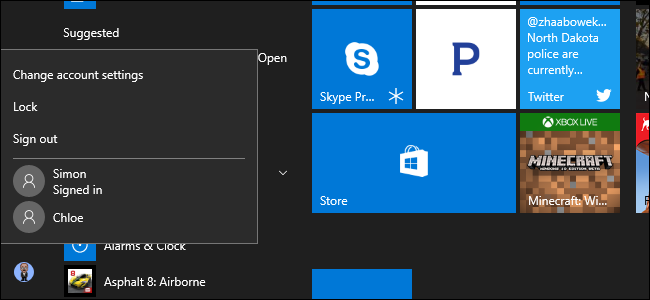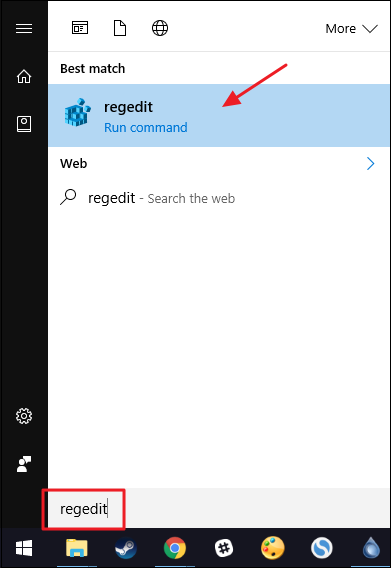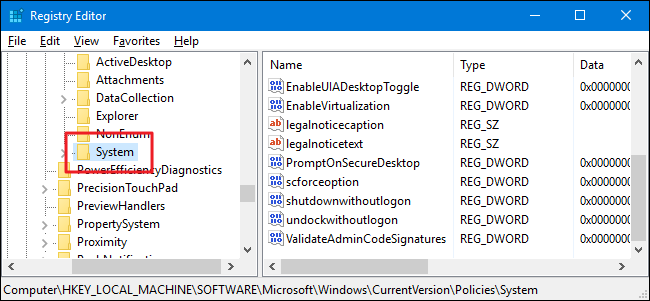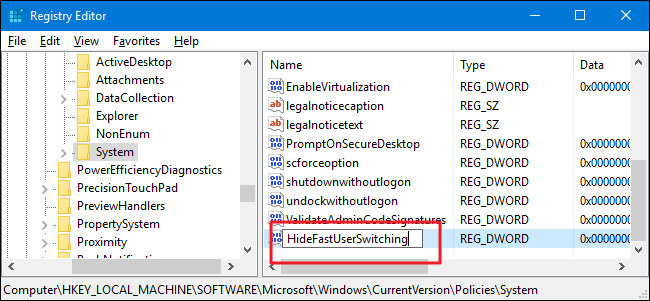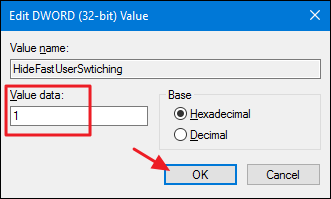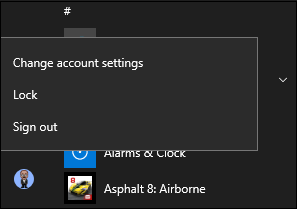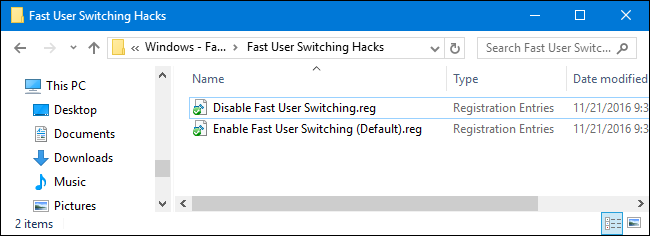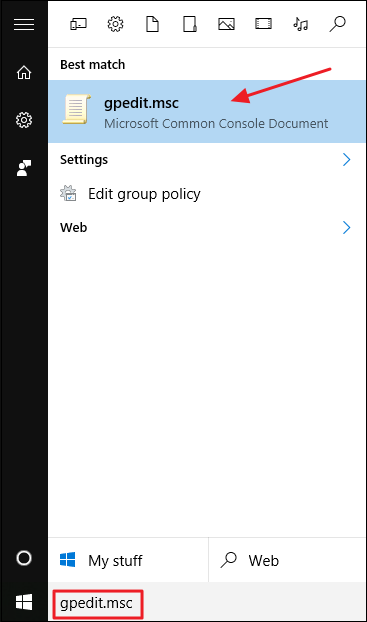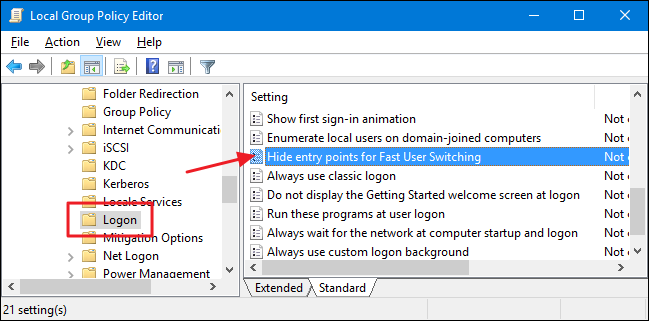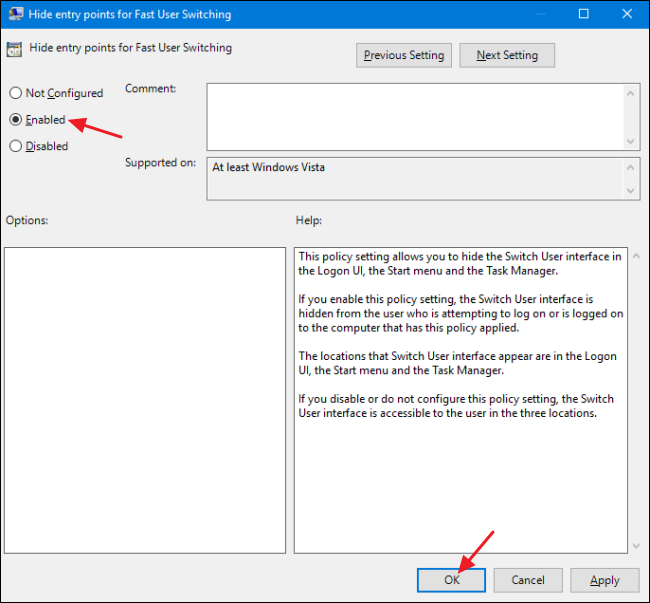Quick Links
Fast User Switching can be handy, but also comes with downsides. Here's how to disable it on all versions of Windows, if you want to.
Fast User Switching allows users to sign into a computer while other users are still signed in. While it offers the obvious advantage of not forcing other users to sign out before you can sign in with your own account, it does have some disadvantages. As long as other users are signed in, Windows is using extra resources on them---especially if they have left resource-intensive apps or background services active. If other users are signed in, you also cannot restart or shut down the PC without having them sign out or risk losing any open files they haven't saved. If you do have multiple users on your PC and you'd rather not have Fast User Switching available, you just have to make a quick edit to the Windows Registry or Local Group Policy Editor.
You should note that this hack does not technically disable Fast User Switching. Instead, it hides all the switch user interfaces that occur on the Start menu, sign in screen, and Task Manager. Once all users have signed out of their user accounts, they will no longer be able to switch to other users using the Windows interface, which for all practical purposes is the same as disabling the feature.
Home Users: Disable Fast User Switching by Editing the Registry
If you have a Windows Home edition, you will have to edit the Windows Registry to make these changes. You can also do it this way if you have Windows Pro or Enterprise, but feel more comfortable working in the Registry than Group Policy Editor. (If you have Pro or Enterprise, though, we recommend using the easier Group Policy Editor, as described in the next section.)
Standard warning: Registry Editor is a powerful tool and misusing it can render your system unstable or even inoperable. This is a pretty simple hack and as long as you stick to the instructions, you shouldn’t have any problems. That said, if you’ve never worked with it before, consider reading about how to use the Registry Editor before you get started. And definitely back up the Registry (and your computer!) before making changes.
To get started, open the Registry Editor by hitting Start and typing “regedit.” Press Enter to open Registry Editor and give it permission to make changes to your PC.
In the Registry Editor, use the left sidebar to navigate to the following key:
HKEY_LOCAL_MACHINE\SOFTWARE\Microsoft\Windows\CurrentVersion\Policies\System
Next, you’re going to create a new value inside the System key. Right-click the System key and choose New > DWORD (32-bit) Value. Name the new value "HideFastUserSwitching."
Double-click the new HideFastUserSwitching value to open its properties window. Change the value in the "Value data" box from 0 to 1 and then click "OK."
You can now close Registry Editor. You'll need to sign out of any user accounts that are currently signed in (or restart the PC) and then sign back in with any accounts you want. Once you've signed in, you can test the change by opening the Start menu and verifying that the option to switch to other users is no longer present.
To reverse the change, just follow the same steps and set the HideFastUserSwitching value back to 0 or delete the value entirely.
Download Our One-Click Registry Hack
If you don’t feel like diving into the Registry yourself, we’ve created two downloadable registry hacks you can use. One hack disables Fast User Switching and the other enables it again, restoring the default setting. Both are included in the following ZIP file. Double-click the one you want to use, click through the prompts, and then restart your computer.
These hacks are really just the System key, stripped down to the HideFastUserSwitching value we described above, and then exported to a .REG file. Running the “Disable Fast User Switching” hack creates the HideFastUserSwitching value and sets it to 1. Running the “Enable Fast User Switching (Default)” hack deletes the value. And if you enjoy fiddling with the Registry, it’s worth taking the time to learn how to make your own Registry hacks.
Pro and Enterprise Users: Disable Fast User Switching with the Local Group Policy Editor
If you’re using Windows 10 Pro or Enterprise, the easiest way to disable Fast User Switching is by using the Local Group Policy Editor. It’s a pretty powerful tool, so if you’ve never used it before, it’s worth taking some time to learn what it can do. Also, if you’re on a company network, do everyone a favor and check with your admin first. If your work computer is part of a domain, it’s also likely that it’s part of a domain group policy that will supersede the local group policy, anyway.
In Windows 10 Pro or Enterprise, hit Start, type gpedit.msc, and press Enter.
In the Local Group Policy Editor, in the left-hand pane, drill down to Computer Configuration > Administrative Templates > System > Logon. On the right, find the “Hide entry points for Fast User Switching” setting and double-click it.
In the properties window that opens, select the "Enabled" option and then click "OK."
You can now exit the Local Group Policy Editor. Sign out of any accounts where a user is signed in (or restart your PC). When you've signed back in to your account, test your change by verifying that the option to change users has been removed from your Start menu. If at any time you want to enable Fast User Switching again, just follow the same procedure and set that option back to Disabled or Not Configured.

